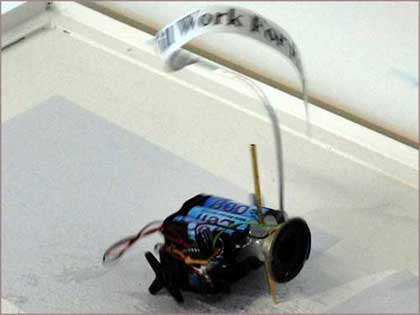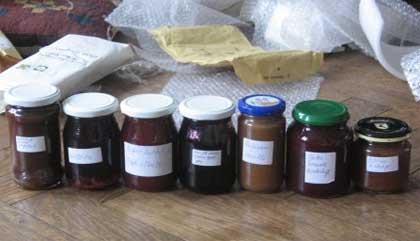Will Work For Food is a project about labour and barter economy. The bread earner is a robot able to draw and whistle “Happy Birthday� and “The Internationale�.

To enjoy those precious services, all you have to do is pack some food (no money!) and send it to a given address. The WWFF vehicle will be posted to you in return.
I asked KH Jeron to tell us more about this idea:
When and how did you get the idea to set up the “Will Work For Food” service?
Before I started with WWFF I built a robot which did drawings for 7.50 € per hour. This was my contribution to the allgirls gallery Christmas exhibition last year.
I wanted to combine utopian ideas of the 50s and 60s of the 20th century which yearned for the liberation of humanity from any form of labour and the discussion about minimum wage in Germany.
The vehicle’s batteries lasted for about 5 hours. So each drawing was sold for 37.50€. After that success, I thought again and decided to do a project where necessarily no money has to be involved. It was in January this year.
 Photo credits, Labor K1: Jana Linke & Juliane Zelwies
Photo credits, Labor K1: Jana Linke & Juliane Zelwies
Given the feedback you got from “Will Work For Food”, do you think that this idea of labour and barter economy could be pushed further and be a bigger part of our economy?
Well, i have never thought about of the barter model of wwff as a bigger part of our economy. There are already very successful marketplaces for cashless business like the largest free barter site or the former ubarter, now called itex in the USA. They say that itex processes over $250 million a year in transactions across 24,000 member businesses and 95+ franchisees and licensees.
WWFF is more about value and trust.
 What was the most unexpected food present ever sent to you?
What was the most unexpected food present ever sent to you?
Just the day before yesterday I received seven different glasses of homemade marmalade.
Can you tell us a few words about the robot itself? What’s the technology you used?
Each of the vehicles is equipped with a ballpoint pen and loudspeakers. The melodies are stored on a micro controller which also
operates the speakers and the randomized movements of the motor.
I prefer to use servo motors, if they are cheap. Otherwise I use standard dc motors with a L293 (see PDF) as a h-bridge driver. The microcontroller is a PIC12F683 from microchip.
The main goal was to build a cheap robot (< 10€). It also has to be light and small. I can send it for 4.50 € all over Europe and for 8 € worldwide.
Thanks KH!
